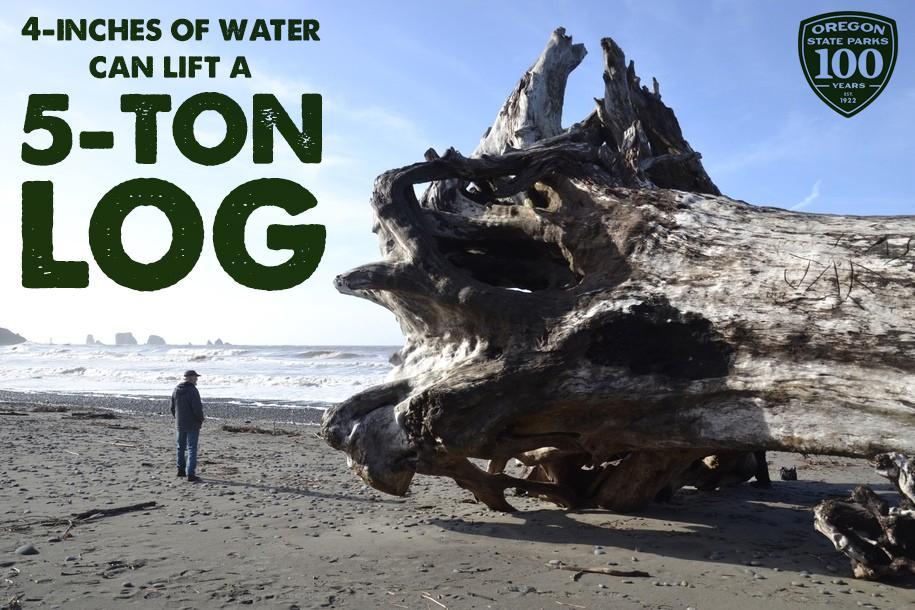Beach Safety
Play Safe at the Beach
The Oregon coast is a natural wonder drawing visitors from around the world to enjoy the rugged beauty. Whale watching, crabbing, beachcombing, surfing or just enjoying the sun and the sand are just a few things the Oregon coast offers.
Don’t let the ocean catch you off guard.
The U.S. Coast Guard and local rescue personnel save many people each year who didn´t respect the ocean´s power. Stay out of rip currents that can carry unsuspecting swimmers out to sea, and keep watch for sneaker waves that can travel far up the beach. Stay off and away from logs that can roll in a wave. These dangers are very real, but are easily avoided by following simple tips and using your common sense.
Enjoy your visit to the Oregon coast and remember to respect the beach!
Be safe, we want you back.
Flood Awareness
Its always a good idea to check what’s happening at the coast.
Things can change really fast and you can be prepared by checking ahead for what to expect.
Here are some great resources to help you be informed:
Tsunami Preparedness
IMPORTANT!
If you feel the ground shake, move quickly to higher ground and safety!
DO NOT wait for an official warning!
If you feel an Earthquake:
- Protect Yourself – Drop, Cover, Hold – until the earthquake is over
- Move quickly inland to high ground and away from low-lying coastal areas
- Go On foot if at all possible
- DO NOT pack or delay
- DO NOT return to shore
- Wait for an “All Clear’ from local officials before returning to low-lying areas
About the Evacuation Brochure & Map
The evacuation zone on this map was developed by the Oregon Department of Geology and Mineral Industries in consultation with local officials. It is intended to represent a worst-case scenario for a tsunami caused by an undersea earthquake near the Oregon coast. Evacuation routes were developed by local officials and reviewed by the Oregon Department of Emergency Management. The Oregon Department of Geology and Mineral Industries is publishing this brochure because the information furthers the mission of the Department. The map is intended for emergency response and should not be used for site-specific planning.
The information in the brochure may save your life.
Please take the time to read it and share what you have learned with your family and friends.
Check your address on the Oregon Coast Tsunami Program website:
Tsunamis & Sirens
As a great portion of the homes and businesses in Rockaway Beach would be damaged in a Cascadia mega-quake Tsunami it is very import to understand how a Tsunami works. Your lives might depend on understanding the differences in a local and distant Tsunami. Located 60-100 miles off of our shoreline lays the “Cascadia Subduction Zone”. An area where two of the great land mass plates meet. One of the plates is trying to dive under the other, and as that happens, pressure builds and when we get a sudden slippage, we get a large earthquake and associated Tsunami. This is called a “local” Tsunami. In this case, you will feel the earth shake for several minutes. THAT IS YOUR WARNING….DO NOT WAIT, AS SOON AS THE GROUND STOPS SHAKING IMMEDIATELY HEAD FOR HIGH GROUND. First wave, of many, may hit our area within 8 min. The first wave is not normally the largest. These waves will have significant impact on our community. Water, sewer, power, roads, and bridges will be damaged. Our area will experience both an earthquake and associated Tsunami’s. However, in a mega-quake type scenario, generated by the Cascadia Subduction Zone, all areas west of the Cascades, from Northern California to the tip of Vancouver Island will have major damage from the earthquake. Supplies coming in will take a very long time, (possibly over 30 days), to reach our community. Emergency planners say this will be much worse than what we saw with Hurricane Katrina.
A Tsunami coming from Alaska, or elsewhere in the Pacific Rim, is called a “distant” Tsunami. We will have early notification and the expected damage to infrastructure will be much less. Scientists can now accurately project the arrival and size of the waves. Because these waves travel a very long distance the damage they create will be much less. For most of these waves people just need to get off of the beach areas and possibly the first dune.
